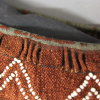woven bag
woven bag
woven bag













Finger woven woollen yarn bag with strap, ornamented with interwoven white beads in geometric designs. On one side: vertical parallel zigzag lines and paired opposing zigzag lines that form diamonds. On the other side: horizontal parallel zigzag lines. Possibly a resist dying technique(?) used on yarn in the fringe. Likely Anishinaabe, made c.1750-1775. Purchased from James P. Economos.
Museum documentation
GRASAC generated
Read More About This Relative
woollen yarn, dyed red and dark brown; blue silk ribbon; white beads
Finger woven woollen yarn with strap, ornamented with interwoven white beads in geometric designs. Opening of the bag is trimmed with blue silk ribbon. Bottom of bag has fringe of threads which are braided and then tied off into loose threads. Some threads are ornamented with white beads. Yarn in fringe has been dyed using a resist dying technique(?). Alternating weaving technique found along the opening of the bag.
One side: vertical geometric designs of double zigzag lines, and diamond pattern or opposing zigzag lines or "X"s. Other side: horizontal geometric designs of double zigzag lines. Resist dying technique in woollen yarn of fringe creates two rectangular shapes. Diagonal lines in interwoven beads of strap.
Museum documentation
Provenance
About This GRASAC Record
Visit to Denver Art Museum of Alex Nahwegahbow and Ruth Phillips, assisted by Eric Berkemeyer and Kristin Strid on 22 Jan 2014
 Knowledge Sharing Platform
Knowledge Sharing Platform












